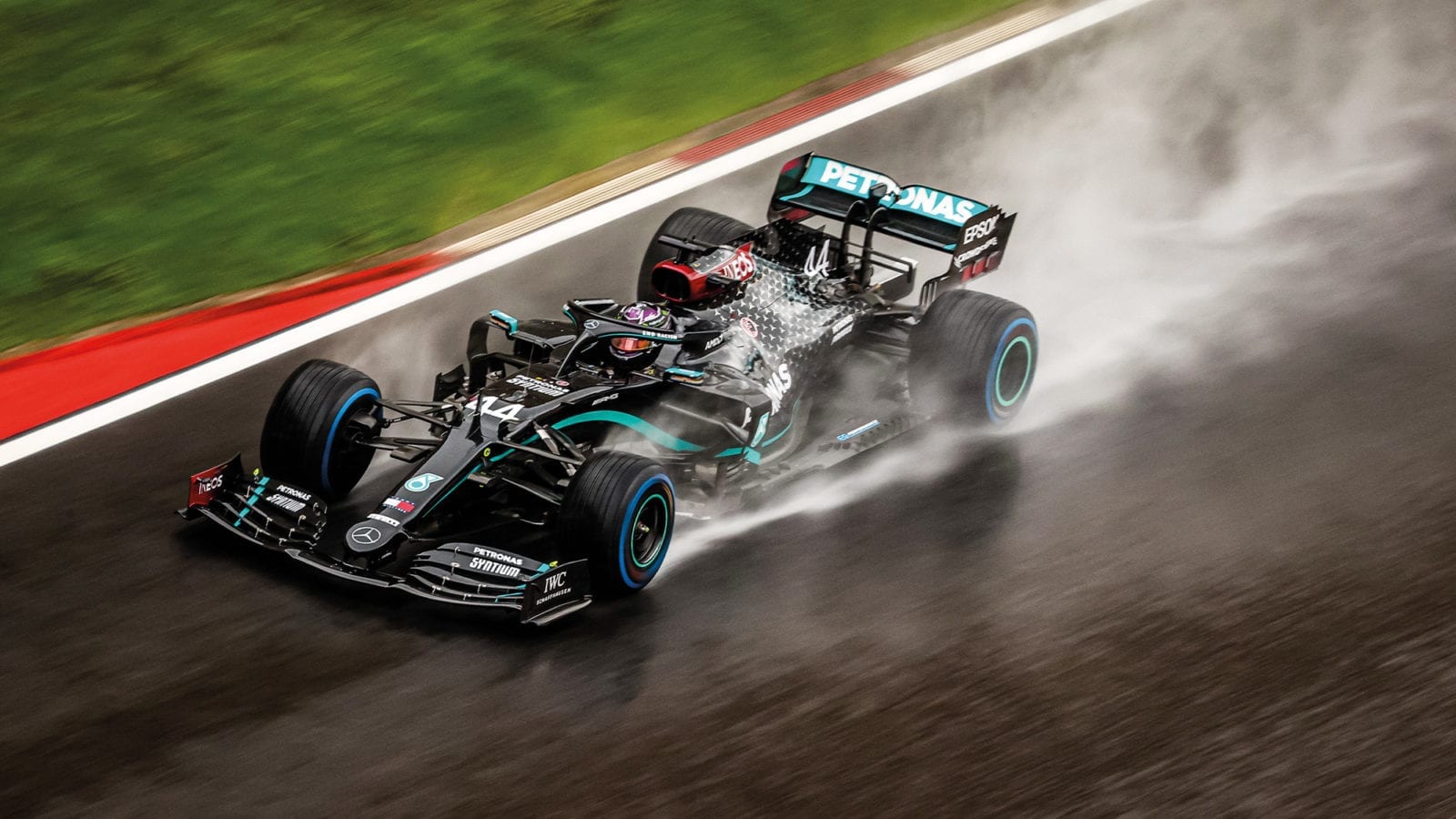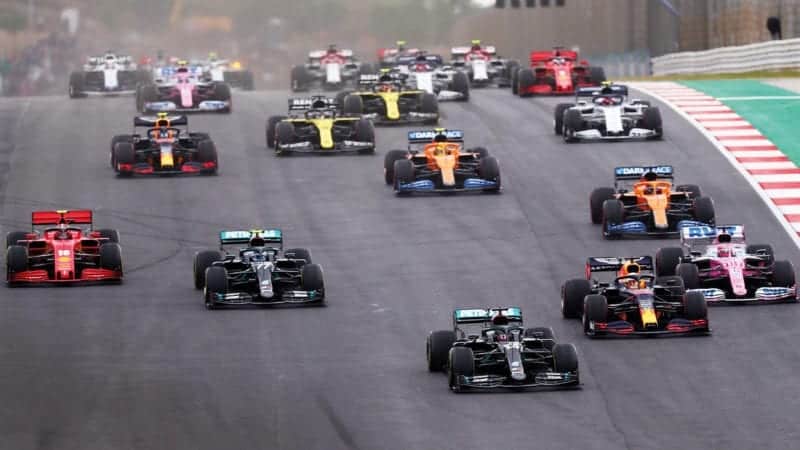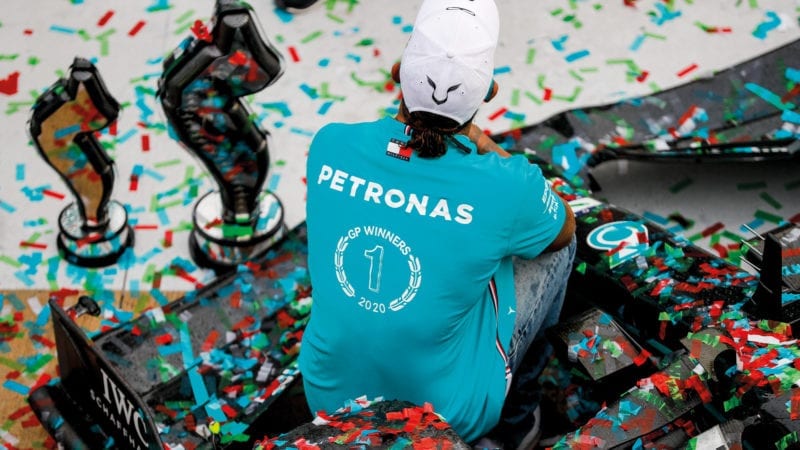Here comes the reign again: final races that secured Hamilton's 7th F1 title
For the seventh time Lewis Hamilton sits on top of the Formula 1 world, and now it seems not so much if, as when, he’ll surpass Schumacher's F1 championship record. Mark Hughes watched the drama unfold amid some tricky driving conditions

Surface spray in Istanbul but there was no stopping Lewis Hamilton. Is his future still with Mercedes for 2021?
DPPI
This trio of pandemic offspring Formula 1 races was where Lewis Hamilton, having equalled Michael Schumacher’s win record at the preceding Eifel race, could first step into his own unique territory of success. Any further grand prix victories would establish new records and his clinching of the latest title would equal Schumacher’s seven. So there was every chance that by the end of this little run, Lewis Hamilton would become the most statistically successful F1 driver of all time.
F1 had only ever used Portimão in the Algarve as a test venue before, but it was built (in 2008) as a fully F1-compliant track and is a terrific venue. It was only ever the commercial realities that had prevented a Portuguese Grand Prix from being held here before. Those realities have, of course, been turned on their head by the pandemic, in that F1 is this season renting any suitable tracks rather than charging promoters for the privilege. There were even a few spectators allowed here.
The circuit dips and dives its way through the countryside with a mix of blind apexes and medium-high speed sweeps. In its demands on the car it’s quite similar to Barcelona and, as such, Pirelli brought its three toughest compounds, keen to avoid a repeat of the British Grand Prix late race tyre failures. It needn’t have worried. The recently resurfaced track was so short of grip, as the new bitumen continued to ooze from its pores, that there was relatively little strain upon the tyres.
The softest compound tended to grain its front left quite easily and didn’t seem decisively faster, even over one lap, than the medium. Getting the race-starting tyre choice right was an important part of the weekend, more so than usual. It was important enough that if Mercedes got it wrong and Red Bull got it right, an upset might have been on the cards. So it was intriguing when Max Verstappen chose to go through Q2 on the softs with both Hamilton and Valtteri Bottas on the mediums. It later turned out that Mercedes had called this absolutely right – and so its usual dominance ultimately played out with a decisive 1-2 (with Hamilton ahead by 25sec) from Verstappen.
But on the way to that conclusion, there was great excitement in the race’s early stages, when it was the softs that were much the faster tyre, on account of the medium taking around four laps to reach working temperature on the cool track. But it wasn’t Verstappen who was best able to take advantage of that. It was the McLaren of Carlos Sainz and the Alfa of Kimi Räikkönen. As the Mercs struggled with tyre temperatures, Sainz was up to second place on the first lap and took the lead from Bottas going into the second. Räikkönen meanwhile had vaulted from a starting position of 16th to sixth in the first few corners and was nibbling at the back of Verstappen.

Tourists at the Algarve, with Hamilton leading
Dan Istitene/F1 via Getty Images
This was all just a temporary distraction from reality. Four laps in, the mediums were up to temperature, Bottas retook the lead from Sainz and was quickly followed through by Hamilton and Verstappen. Räikkönen sank back down to the Alfa’s natural mid-grid level. Hamilton took a while working out the new requirements of a very blustery day while retaining crucial temperature in the medium tyre. Once he’d done so, he was able to begin applying pressure to Bottas who was increasingly struggling with under-temperature fronts as they wore down. Wrestling with the car through one of the slower corners at the end of the lap lost him momentum through the fast sweep onto the straight. Because the tyres were not overheating when in the wake of another car, Hamilton was able to stay glued to Bottas’ rear wing through there– making a DRS-assisted pass on the pit straight just a formality. So the historic 92nd grand prix victory of Hamilton’s career, a feat no-one had ever achieved before.
Formula 1 returned to Imola for the first time in 14 years for the Emilia Romagna Grand Prix, uniquely a two-day event so as to give the trucks time to make the journey from Portugal and set up shop in the paddock here. Bottas, very often fastest on the first day, was in his element during qualifying. He duly pipped Hamilton to pole position. Things looked even better for him at the start, as he surged into an immediate lead and Hamilton was pushed down to third by the faster-starting Red Bull of Verstappen. With a slower car between him and his team-mate and the difficulty of passing around this track, it all looked in place for Bottas who was in scintillating form on the first lap, aggressively using the kerbs and pulling out a big lead.
Hamilton was glued to Bottas’ rear wing, then passed on the straight
Rounding Tosa on the second lap, he spotted, too late to avoid it, a piece of red debris. He at least avoided driving over what was, in fact, a discarded piece of Sebastian Vettel’s front wing with his tyres. Instead, it lodged itself in Bottas’ right-hand barge board. In such an extremely aerodynamically sensitive part of the car, it cost what the team later reckoned was between 0.7-0.8 seconds per lap of performance. Suddenly, Verstappen and Hamilton were right back with him. He could maintain position but he couldn’t pull away. So when Red Bull brought Verstappen in early in an attempt at undercutting past, Mercedes had to pit Bottas in response to have any hope of retaining track position over the Red Bull. He got out still just ahead.
But that left Hamilton leading on tyres that still had many laps of life left in them, on account of their early stops. If he could extend his 20sec lead by another 4sec before his tyres wore out, he’d be able to pit and get out still in the lead. He set about doing that on old tyres versus Bottas’ new, but with a healthy car versus Bottas’ compromised one. He’d just about got the gap out to what was needed when he was helped further by a VSC to retrieve Esteban Ocon’s broken-down Renault. With the field reduced in pace, Hamilton no longer needed as big a margin to pit and get out still ahead. Which is what happened. The VSC had made it easier, but it had been set to happen anyway.
Verstappen eventually got by Bottas after the latter’s problems caused him to lock up and dip a wheel into the Rivazza gravel. But Verstappen didn’t get to stay second for very long. A sudden failure in his right-rear tyre led to a high-speed spin into the gravel trap at Villeneuve. This allowed Mercedes to bring both cars in for a precautionary change of tyre – Hamilton had been complaining of a vibration which may have been the precursor to the sort of failure Verstappen had suffered. It wasn’t Hamilton’s most devastating win of the season, but they all count in the record books.

Imola’s first GP since 2006 saw Hamilton edge closer to the title
Mercedes-AMG
Istanbul Park last hosted the Turkish Grand Prix in 2011 and of the current drivers only Räikkönen, Hamilton and Vettel had raced there. What greeted them as they arrived was a very Portimão-type relaid surface. The late-notice nature of the agreements in this improvised calendar mean such things are inevitable, but the lack of grip was extreme. “I cannot even go flat on the straight,” laughed Lando Norris on the radio on first getting out there on Friday. It certainly made for some impressive displays of rally-like car control.
But what the extreme lack of grip also did was make it impossible for Mercedes to get sufficient heat into its rear tyres during qualifying. Practice had established that it took around seven laps to bring the rubber in – not a luxury that qualifying allows. So for the first time this season it wasn’t a Mercedes on pole. Hamilton in the faster of the two W11s was only sixth-fastest – a rather lengthy 5.5sec behind Lance Stroll’s pole-setting Racing Point!
It was Vettel’s first podium of a difficult final season at Ferrari
Mercedes was quietly confident it would be in better shape in the race, despite the wet track. The early stages were all about Stroll and Sergio Pérez running in impressive 1-2 formation in the pink Racing Points, though once everyone had switched from wets to inters and got them up to temperature, Verstappen and Alex Albon were catching them in their Red Bulls.
Verstappen spun trying to pass Pérez and was forced to pit to replace his flat-spotted tyres. Hamilton had made quiet progress and was up to fourth by the 33rd lap. That became third as Albon, on heavily worn tyres, spun. The leader Stroll was also by then suffering with his tyres and pitted, putting Pérez in the lead but only by a few metres from the advancing Hamilton, who took the lead with a DRS pass on the 37th of 58 laps. From there, he pulled away at around 2sec per lap, enjoying the inters as their tread wore down to slicks on the drying track but somehow keeping them alive.
Pérez pulled off the same trick but was under attack from the newer-tyred Ferraris on the last lap. Charles Leclerc squeezed ahead but then locked up, allowing not only Pérez to nip past, but Sebastian Vettel too. It was the German’s first podium of what has been a difficult final year at Ferrari.
With that, Hamilton became a seven-time world champion. Only Bottas could have prevented it here, but he’d suffered an awful day, finishing 14th after six spins due to steering damaged on the first lap.

